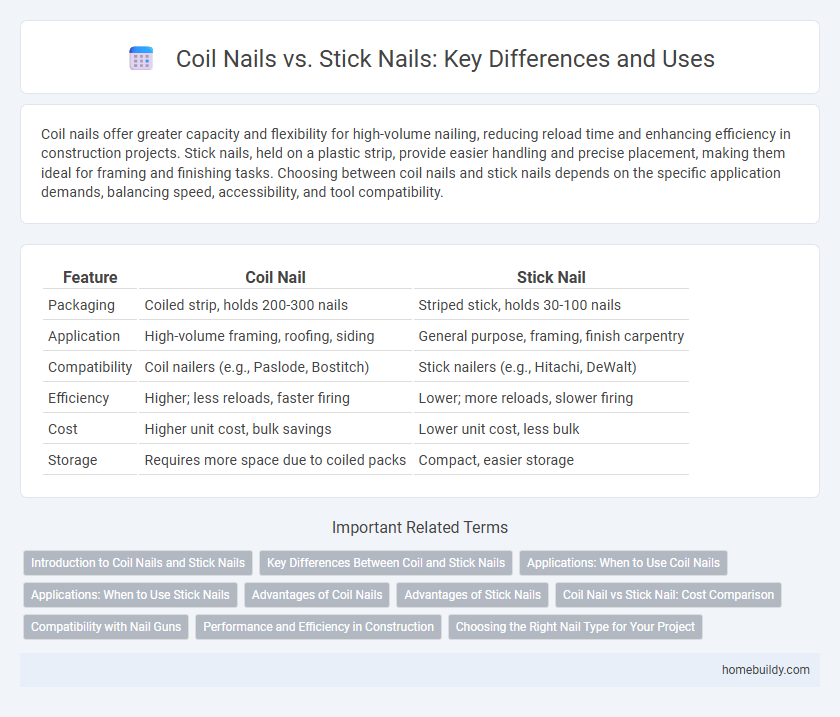Coil nails offer greater capacity and flexibility for high-volume nailing, reducing reload time and enhancing efficiency in construction projects. Stick nails, held on a plastic strip, provide easier handling and precise placement, making them ideal for framing and finishing tasks. Choosing between coil nails and stick nails depends on the specific application demands, balancing speed, accessibility, and tool compatibility.
Table of Comparison
| Feature | Coil Nail | Stick Nail |
|---|---|---|
| Packaging | Coiled strip, holds 200-300 nails | Striped stick, holds 30-100 nails |
| Application | High-volume framing, roofing, siding | General purpose, framing, finish carpentry |
| Compatibility | Coil nailers (e.g., Paslode, Bostitch) | Stick nailers (e.g., Hitachi, DeWalt) |
| Efficiency | Higher; less reloads, faster firing | Lower; more reloads, slower firing |
| Cost | Higher unit cost, bulk savings | Lower unit cost, less bulk |
| Storage | Requires more space due to coiled packs | Compact, easier storage |
Introduction to Coil Nails and Stick Nails
Coil nails are collated in a circular pattern on a flexible strip, allowing for high-capacity holding power and efficient use in pneumatic nail guns, especially in framing and roofing applications. Stick nails are arranged in a straight strip, making them compatible with nailers designed for linear feeds, often preferred for finishing and trim work due to precise placement and reduced surface damage. Both coil and stick nails vary in size, wire gauge, and coating, catering to specific construction needs and material compatibility.
Key Differences Between Coil and Stick Nails
Coil nails are collated in a circular coil shape, allowing for larger capacity and longer continuous nailing, ideal for high-volume industrial applications. Stick nails, arranged in straight strips, provide easier handling and faster loading for smaller pneumatic nailers used in framing and cabinetry. The choice between coil and stick nails depends on project scale, tool compatibility, and desired efficiency in fastening tasks.
Applications: When to Use Coil Nails
Coil nails are ideal for high-volume applications such as roofing, siding, and framing due to their ability to hold more nails per load and reduce reloading time. Their flexible strip design allows for better maneuverability in tight spaces and curved surfaces compared to stick nails. For projects requiring fast, continuous nailing with minimal downtime, coil nails offer superior efficiency and performance.
Applications: When to Use Stick Nails
Stick nails excel in framing and heavy-duty construction projects requiring rapid, sequential nailing due to their collated alignment, which facilitates quick loading and fewer jams in pneumatic nailers. Ideal for exterior sheathing, subflooring, and rafters, stick nails provide consistent driving depth in dense materials such as hardwoods and structural lumber. Their compatibility with various framing nailers makes them preferable when speed and efficiency in large-scale builds are prioritized over the compact storage benefits of coil nails.
Advantages of Coil Nails
Coil nails offer superior capacity by holding significantly more nails in a single strip, reducing frequent reloads and enhancing productivity on large-scale projects. Their flexible collated design ensures easier maneuverability in tight or awkward spaces, improving precision and accessibility compared to rigid stick nails. The compact, coiled configuration also minimizes jamming in pneumatic nailers, increasing tool longevity and operational efficiency.
Advantages of Stick Nails
Stick nails offer superior handling efficiency and faster loading times compared to coil nails, reducing downtime during construction projects. Their standardized arrangement ensures consistent feed reliability, minimizing jams in nail guns and enhancing productivity on-site. The compact packaging of stick nails also simplifies transportation and storage, making them ideal for high-volume applications.
Coil Nail vs Stick Nail: Cost Comparison
Coil nails generally offer a lower cost per nail compared to stick nails due to their packaging efficiency and reduced waste during usage. Stick nails tend to have higher upfront tool compatibility costs and may require more frequent reloading, increasing labor expenses on large projects. Choosing coil nails can lead to better overall cost-effectiveness in high-volume fastening tasks, especially in framing and roofing applications.
Compatibility with Nail Guns
Coil nails offer superior compatibility with high-capacity coil nail guns, enabling faster and more efficient nailing for large-scale projects. Stick nails are designed for standard framing nailers and are ideal for straightforward, smaller tasks requiring less frequent reloading. Selecting the right nail type ensures optimal performance and reduces the risk of jamming or misfires in compatible nail guns.
Performance and Efficiency in Construction
Coil nails offer higher performance in construction projects due to their greater holding power and improved resistance to splitting, making them ideal for heavy-duty framing and industrial applications. Stick nails provide efficiency advantages with easier loading and compatibility with standard nail guns, facilitating quicker tool changes and reduced downtime on smaller-scale tasks. Choosing between coil nails and stick nails depends on balancing the need for enhanced fastening strength versus operational speed and convenience on the job site.
Choosing the Right Nail Type for Your Project
Choosing the right nail type depends on the specific application and tool compatibility; coil nails offer higher capacity for prolonged use in pneumatic nailers, making them ideal for large framing or decking projects. Stick nails, arranged in strips, provide easier handling and faster reload times for smaller-scale jobs or finishing work. Selecting coil or stick nails based on project size, material type, and nailer type ensures optimal fastening strength and efficiency.
Coil Nail vs Stick Nail Infographic

 homebuildy.com
homebuildy.com